The annual car show every September in Geneseo, IL, home of my Packard-restoring buddy, Dave Mitchell, is one of the best of the year. Even cars that are rarely seen usually show up, including an ex-service station Corvair Rampside, a Sunbeam Alpine roadster with factory hardtop, a simply fantastic 1960 Chevrolet Nomad station wagon, various excellent Studebakers and this original-condition, one-family-owned (at the time) 1970 Camaro.

The ‘70.5 Camaro (so called because the uber-recognizable 1969 Camaro continued well into MY ’70 as an ‘early 1970’ model), was a surprising twist to Chevy’s ponycar. Gone was the three-box 1967-69 styling, replaced with Bill Mitchell’s interpretation of classic Italian lines-Ferrari in particular. It was a decade before I came on the scene, and 20 before I really started identifying cool old cars, but I think it is safe to say no one was expecting such a sleek, sexy design. It was especially beautiful with the RS split bumper, as shown above.

But guess what happens to every damn surviving Camaro, Mustang, Barracuda and Challenger? You guessed it: Folks with fat wallets have to take every freaking one of them and paint them red, stuff a big honking engine in them, and then add all the items that were probably limited to less than 10% of production when new: rally wheels, spoilers, stripes, Hurst shifter, power windows, sport mirrors, AM/FM/8-track, traction bars (or are those passé these days?) and the like. Or resto mod them, or add damfool Foose wheels. Etcetera, etcetera, ad infinitum.
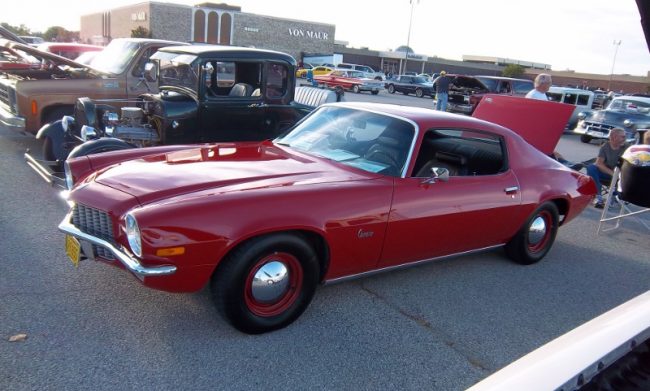
You know the drill: Make it match the car they wanted when they were twelve and the cars were new. For some, even that isn’t enough, and entire drivelines from new cars, rubber-band tires on 18″ or 20″ wheels, ugly fiberglass dashes replacing the factory instrument panel, and everything else under the sun is added. Oh, and don’t forget the ill-fitting, Chinese made SS emblems! Ha ha ha.

That’s all fine and good (or not), but I appreciate an original car much more. Individual Mustangs and Camaros, when new, were quite different from car to car; you were unlikely to see two that were exactly the same. For example, my dad’s first car was a straight-six powered 1965 Mustang convertible, Poppy Red with white stripes, white interior and top. It was sharp, it was sporty–and it was slow! It had been his dad’s secretary’s car, and my grandfather rightfully assumed that he couldn’t get into too much trouble with it. As Dad told me, it was all show and no go, but that’s largely how it came off the line new-though Dad did add the white GT-style rocker panel stripes.

Thus it goes with the majority of pony cars today, and so I initially passed over this Camaro, assuming incorrectly via my peripheral vision that it was a mid-life crisis upgraded hot rod. As it turned out I was 100% wrong. On my way back, I actually looked at it and noticed the baby moon hubcaps: “Oh, that’s cool.” Then I saw they were factory hubcaps, and, holy crap. It had the standard six cylinder engine. Inside was an all-business black interior with the standard vinyl buckets, no console and a column-mounted two-speed Powerglide automatic.
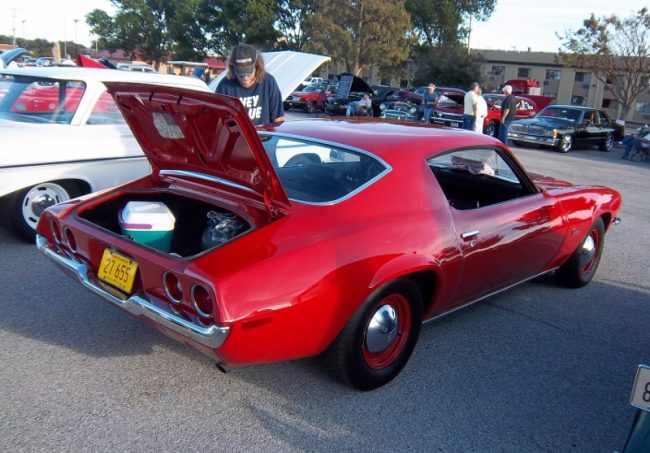
Who would order such a car? Well, as I learned, the original owner was a lady who just wanted a sporty car, but one with no frills–and indeed, this car is quite frill-free, with its standard 155-hp six, Strato-Bucket seats, carpeting and Astro Ventilation.
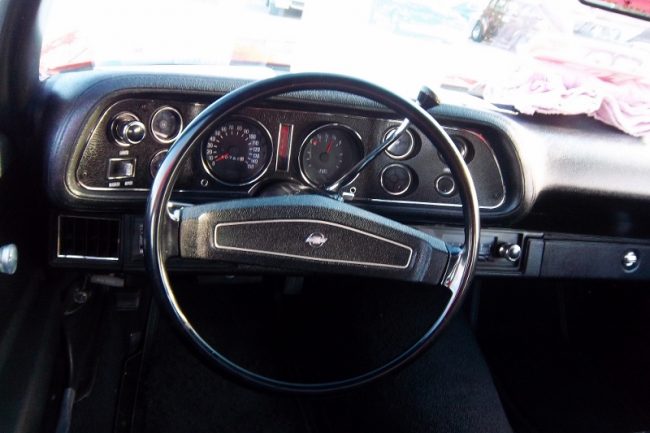
The meager options on this car include a tinted windshield, AM radio and whitewall tires: no console, no A/C, no power windows and no sport mirrors. In other words, none of the stuff that sets Camaro guys’ hearts beating faster! No boy-racer horse hockey–and for that reason, I loved this car.
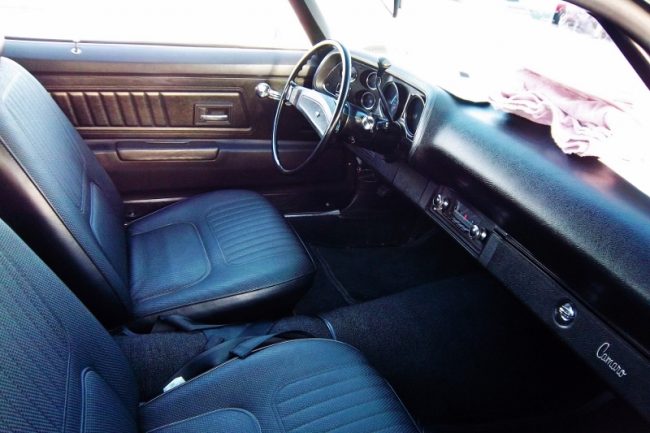
Even in basic form, like this one, the ‘70.5 Camaro’s lines are still lovely. Those slim chrome bumpers, the grille standing proud of the headlight bezels, that quartet of round taillamps–all lovely. And so different from the usual ’70 to ’73 Camaros usually seen at cruise ins and car shows every summer.

If it still looks good without any optional plumage to enhance its basic form, it’s a worthy vehicle, at least aesthetically. When you apply that standard to the 1970.5 Camaro and its corporate sibling, the equally sharp Pontiac Firebird, it still shines.
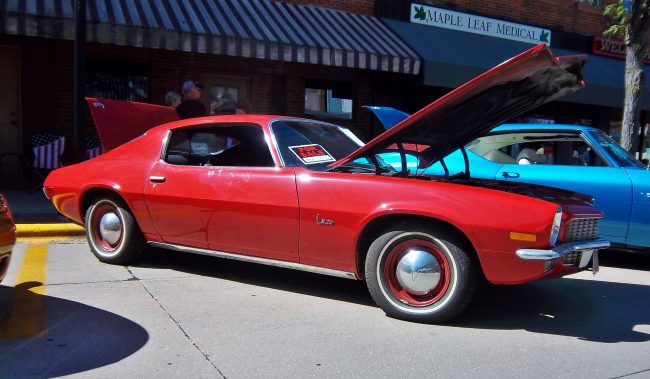
The man displaying this car back in September 2012 was the original owner’s nephew, and he was old enough to remember when she brought it home. It was purchased at Cambridge Motors, in Cambridge, IL, a small town about a half-hour from the Quad Cities.
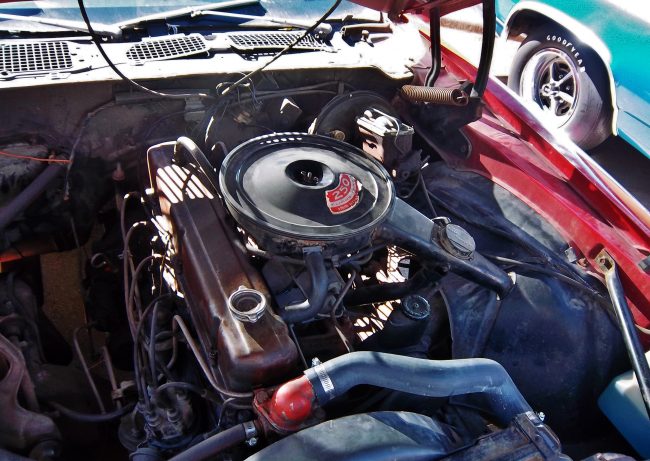
This car is an amazing time capsule, with original paint and engine, and only 59K miles. I did not begrudge him too much for asking ten grand. After all, where else will you find a car like this one? And it was rust free, needed nothing, and was ready to rock and roll. The price also ought to dissuade idiots from ripping the car apart, painting it bright yellow, shoehorning in a 502 big block and adding stripes and pretentious aftermarket wheels. If you’re going to mod a car, please do it to a basket case, not an unrestored original. Thank you.
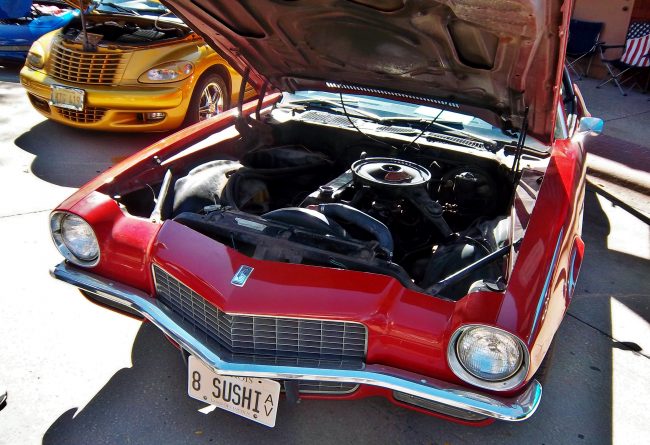
I can see the appeal of a car like this. This car, with its six-cylinder engine, Powerglide and hub caps, is equipped like a plain-Jane Nova, but in a swoopy Bill Mitchell-designed Italian dress. Kind of like the attractive lady librarian with the sensible shoes, unpretentious clothes and tortoiseshell glasses. Even all those things can’t hide her inner beauty. So it is with this ’70 Camaro.
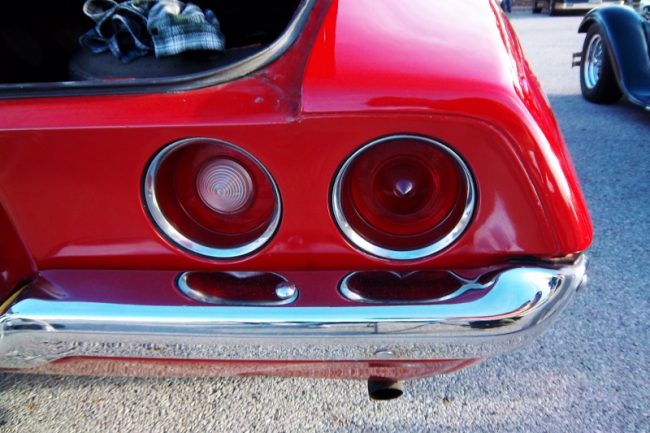
For an original car, it was in fine shape. Naturally, there were a couple of minor bumps and bruises, but that did not detract from what a nice car it was. And all the cool details of these Camaros are still evident, like that veed grille, fastback roofline and smooth flanks.
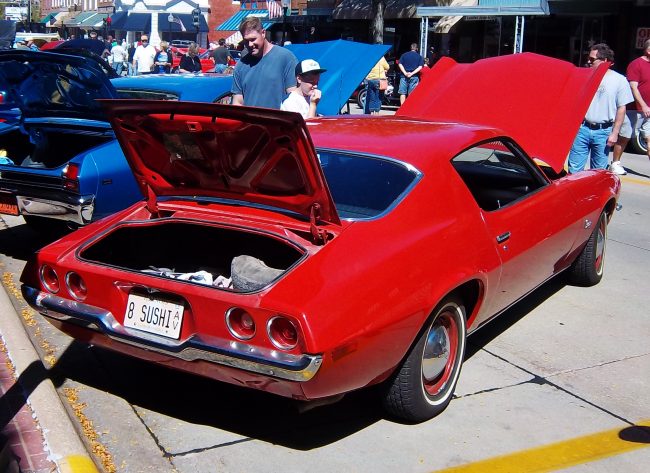
It even still had the original trunk mat, which the owner’s nephew told me was very hard to find NOS these days. Could there be another ‘70.5 Camaro in existence that is still equipped like this one? Perhaps so, but my guess is that most surviving Camaros originally equipped with the six are now Z-28 “tribute” fakety-fake fakes.

It’s kind of like all the original Slant Six or 318 V8 powered Barracudas and Gran Coupes that are now, of course, “tribute” Hemi ‘cudas. I’d like to take a “tribute” Hemi ‘cuda, paint it mint green with a white vinyl top and give it whitewalls, the “salt shaker” deluxe full wheel covers and a 318 V8! Muhahahahaha!
And why not? That’s probably how it started life.
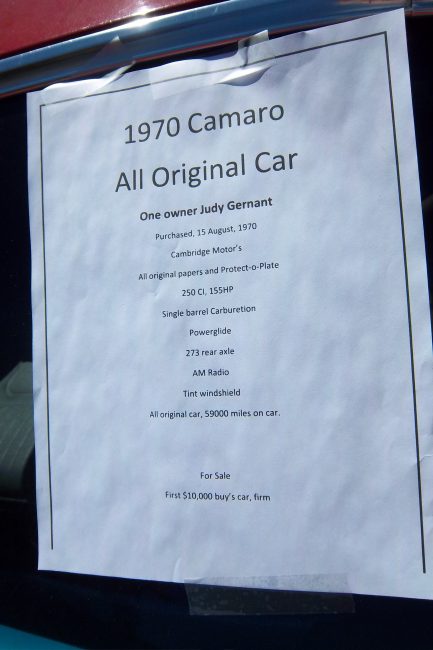
There may come a time when no one remembers that not all pony cars and mid-size sporty cars were muscle cars–not by a long shot. I know we’re already halfway there; on a recent TV show, someone mentioned a Ford Maverick as a muscle car. They appeared to be serious.
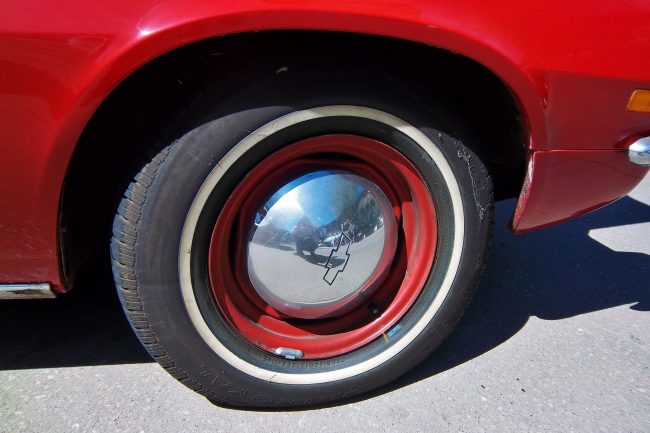
I see I’ve digressed again. Never mind! In any case, Camaros with the six were rare even when new. Out of 117,604 1970.5 Camaros produced, only 12,566 had the Turbo-Thrift Six. How many can be left?
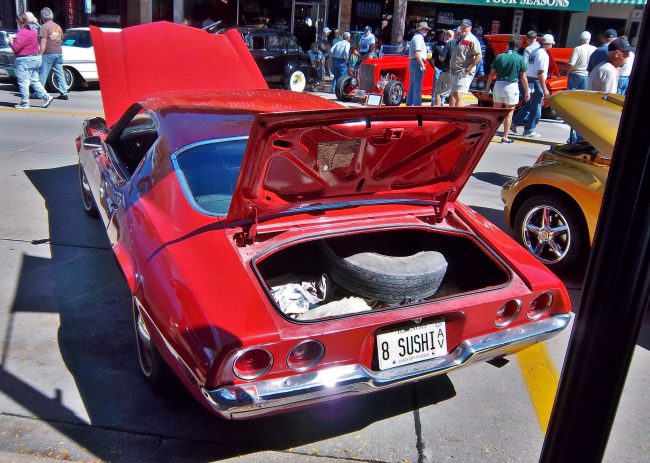
Not many, that’s for sure. At the time, I sincerely hoped that the next owner of this car would keep it as it is. That seemed to be borne out, as the pictures of the car with new blackwall tires were taken in September 2013, a year after I initially sighted this time capsule. Sadly, however, I haven’t seen it since.
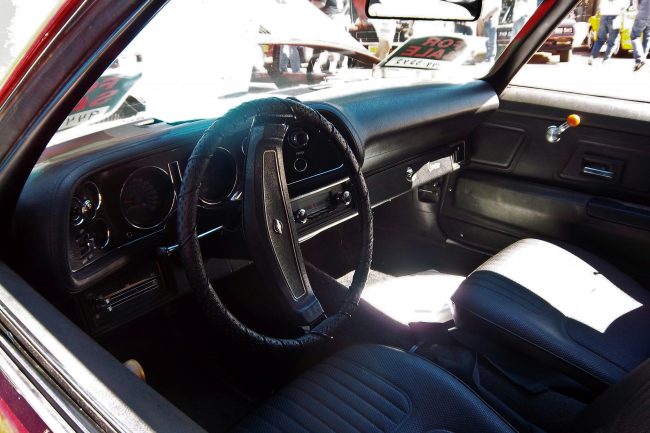


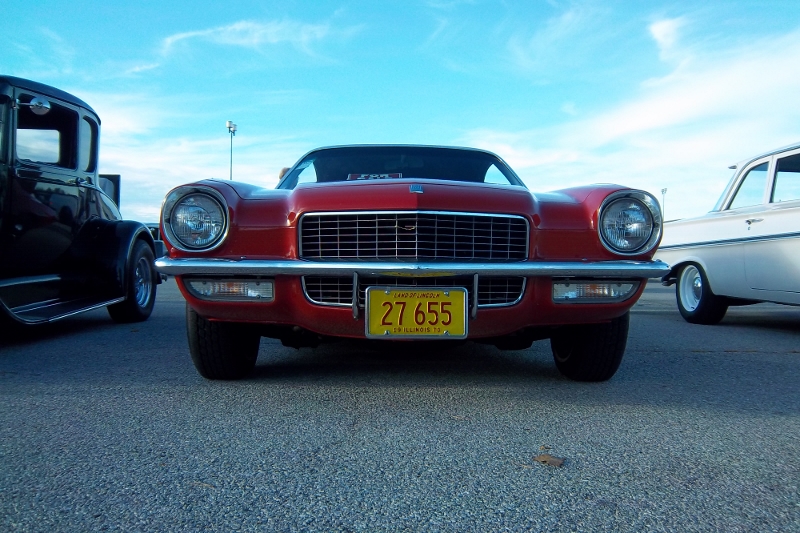
























26 Comments
I love it .
-Nate
This is such a nice car. What struck me was the 2.73 axle ratio combined with the 2 speed auto. These were far from lightweights even before the big bumpers. So definitely not fast. Still relaxed in the American fashion though. The ad slogan then was see the USA on your Chevrolet. Well this car could hit the interstate in a way that the Pininfarinas it was allegedly copying could not. Imagine a car for the young that actually imparted a new freedom, Bill Mitchel could.
Remember the excitement among a certain group when our Japanese friends started offering five speeds a few years later. Working through all those gears still left you in a shorter top gear than this combo. It was of course just a work around for too small an engine. America sure gave you a lot for not much money. Tom in this great article touched on how Mustang and Challenger did the same. To that he could have even added Vega, Gremlin, and at least the later Pintos if he wasn’t trying to prevent our Austrian friend from blowing a gasket. People like to assume that their was no real engineering going on in America, but this new freedom aimed at the young did not just happen.
This beautiful girl who used to drive me home from work at my first job; washing dishes for Western Sizzlin’ when I was fourteen years old, had a red six-cylinder second-generation Camaro. It was closer to the end of production, had a three-on-the-floor shifter, and was in near-new condition. I find the early production cars much more attractive, but the column-shift automatic goes a long way to making this car seem like a Nova with a small trunk.
These most attractive of Camaros have always been relatively scarce. They were late for 1970, had production limited by strikes in 1971, and then lost more than half of projected 1972 volume to strikes. By 1973 performance was a shadow of 1970 and the bumpers were coming. I don’t know if charging a price far above the car’s driving characteristics will protect it from cloners. Anyone who knows what it costs to get a used up car into paint would happily pay ten grand for this car to build a Z28 with an LT1. I get it that this is a rare car, but part of the reason it is rare is because a version that went as well as it looked was right there on the option sheet.
“But guess what happens to every damn surviving Camaro, Mustang, Barracuda and Challenger?”
Ha. Guilty. I just did the Performance Pack 3 upgrade on my 2015 Mustang GT/PP. So I’m just a little early, getting the mods done before it’s (maybe) desirable as a classic. But hey, the upgrade uses only OEM parts and comes with a factory tune… and holy hell does the thing scream now.
I was looking at that Camaro thinking, “man, that would make a great sleeper”… keep it away from me.
What a nice time capsule that demonstrates how poor the “middle class” were just a couple of generations ago. This car provides some accurate perspective with regards to Jack’s essay from a few days ago lamenting the difficult economic situation facing millennials, who can’t keep up the standard of living of their parents, because this car much more accurately represents the type of car that most young people bought if they could afford a newish car back in the day. Movies, TV shows, and cars and coffee events almost always show 55 Chevrolets, 65 Mustangs, and 71 Camaros all decked out with the hottest engine, fastest transmission, sportiest wheels, and most luxurious interiors available, but most young people of the time could only afford to buy and operate a much more bare-bones version. Imagine how many would be sold to millennials today if Chevy or Toyota offered a sporty looking car that did 0-60 in 16-20 seconds, could comfortably cruise at no more than 65 mph, included a 1 year 12,000 mile warranty, but no A/C, no power steering or brakes, no power windows or seats, no 10.2 inch infotainment screen or Apple Carplay, and no airbags or crumple zones all for a price of $15-17,000. I expect they would sell dozens of them.
This car also reminds me of a question that perhaps someone in the audience can answer. Why did virtually all the sixes from the Big 3 only use 1 barrel carbs? I know Pontiac offered their OHC 6 with a 4 barrel, and Chrysler offered some hotter carb options as a dealer installed accessory for the Slant Six, but 99% of them were strangled by a 1 barrel carb, while imports much more frequently used multiple carbs or a 2 barrel even on small 4 cylinder engines. Was it simply a mechanism to encourage more people to buy the V-8 version, or were the engineers worried that better breathing and fuel flow would cause over-revving and thrown rods with the low performance (i.e. cheap) crankshaft and rods they put on their “economy” six engines? If Jaguar had been able to build this Camaro with their E-Type DOHC six, 4 speed, and IRS, installed some nice leather and wood from their XJ in the interior, and sold it for 3+ times the Chevy price, the magazines would have been competing for superlatives to describe the car.
As with the Jaguar, a three times the price Camaro with all those things would be given a short rundown on the features list and then a long rundown why buying a car from GM/BL was something only a chump/Nixon stooge/ baby killer would do. The same way it happened when the 65 and later Corvette added the irs/discs. That car really needs x/y/z. GM-We added them. Well we don’t want them from you, we just loathe you and all you stand for…
Which domestic inline six engine circa 1970 had poor durability, except maybe the last of those ohc Pontiac sixes designed by that clown with the sideburns who couldn’t spot GM through his cloud of cocaine? None of them, they only provided the frugal and less well off a smooth driving experience that they were sure not going to get from the guy overseas.
The durability of the American inline sixes was high, but perhaps only because their restrictive carbs, intake and exhaust manifolding meant they could never be revved very high unlike the foreign fours or the short-stroke domestic V-8s. I love a good inline six, but it never seemed the Big 3 put much effort into theirs beyond making them durable. As for the OHC Pontiac – from what I understood it was a very durable engine with good performance potential – in fact if I remember correctly Car & Driver put a Sprint version in a Jag E-type and commented very favorably on it. The rubber timing belt was very innovative, and even if it snapped the non-interference head design meant the pistons and valves would never have engine destroying contact. The problem from what I understand is that most Americans with a performance desire simply preferred to order the 389 V-8 rather than mess with the Sprint OHC 6 when gas was 25 cents per gallon, so Pontiac and GM never got much credit or profit for their straight six innovation efforts.
“Why did virtually all the sixes from the Big 3 only use 1 barrel carbs?”
Because they were not designed for high rpm’s. They were designed for low rpm torque, therefore a high flow carb, ie 2 or more barrels, wasn’t needed. Also the fuel economy would have been worse, which is why most folks chose the 6.
As you noted, there were some exceptions. I would also include the late 60’s Chevy 292 inline 6 which DID come with a 2 barrel carb and would run like a scalded dog.
The fuel economy argument favoring a 1 barrel is interesting, but from my experience a 2 barrel with a small primary and larger secondary will typically get better fuel economy than a 1 barrel as long as you don’t tip the throttle into the 2nd barrel too often. I’ve driven a 292 in a truck, but did GM ever put the big six into a car?
“but from my experience a 2 barrel with a small primary and larger secondary will typically get better fuel economy”
100% correct. However 99% of shoppers for an “economy” car think that a 2 barrel will be less efficient than a one barrel, no matter who tells them different.”My grand daddy got 138 mpg with a 1 barrel on his model A so why would a 2 barrel be better?”
AFAIK GM didn’t put the 292 in cars. Shame as it was a damn good engine.
When Chrysler put the two barrel on super sixes and when AMC put the two barrel on their 4.2 six for the Pacer the EPA numbers went south.
Our Japanese friends were big into staged two barrels, but they were not offering one barrel versions to compare the economy. It seemed to me another work around for a small, weak engine. It was no doubt better than the European practice of two one barrel carbs on the performance option. Too complicated that and becoming a lost art on how to tune them for the survivors.
Four bottom end bearings don’t make for a good high performance six. The best of the Detroit sixes was the slant-six, and the best moment for the slant-six came in the compact sedan support races for the 1960 Daytona 500. The Valiants that kicked sand in the pansy faces of eight Volvos, five Corvairs, three Falcons and assorted other piddlers had the 170 ci low deck height variant of the slant coupled with the ‘Hyper Pak’ split header, 4-barrel carburetor, and long runner intake manifold.
The Hyper-Pak brought the 170 up from 101 to 148 gross horsepower, which turned out to be more than enough to make all the other compact sedan makers’ efforts look ridiculous. The only problem was that the Hyper Pak was available through dealers for $403.30, more than 20% of the base price of a Valiant. Or, for probably significantly less than $100, the customer could order a 225 ci slant with a one barrel carb that made 145 gross horsepower. The 225 could be treated harshly and still hold up as well as anything from Detroit. A Hyper-Pak 170 was relatively stressed by comparison. A couple years later, the 273 LA would make the concept of a performance six irrelevant at Chrysler. A few years after that, the 4 barrel version of the 273 would vanish with the introduction of the 340 LA.
Eventually there was a 2 barrel slant ‘Super Six,’ but I think it was because emissions controls had deprived the standard engine of its ability to keep up with traffic while CAFE was forcing Chrysler to keep selling them.
You had posted this on the other site, correct? Still looks great, but a mild disappointment that you lost track of it. Hopefully it didn’t get “tributed”. They can only be original once.
I used to have a subscription to High Performance Pontiac magazine and one of their articles was on some GM engineer’s hot Firebird from back in the early 70’s. The car was equipped like most average cars back then, including a column shift. The next month’s mail column was filled with letters claiming the car was not original, because of that column shift. I guess after decades of seeing “Bandit” T/A’s no one remembered what a regular Firebird looked like…
This spirit of this car reminds me of my mother’s 1981 Mustang Ghia. When my late mother turned 60, she was newly widowed, but my dad left her in a pretty good financial position. The Mercury Montego we’d had for seven years was mechanically OK, but the body could no longer withstand the ravages of road salt; she decided to get a nice car for herself. She bought a 1981 Mustang Ghia. It had a very sporty two tone blue exterior with a rather nice light blue vinyl interior. Ford did a good job on interiors back then. But, the car came only with the 2.3L motor, the autobox, power steering and brakes. No power windows, locks, sunroof, etc., etc.
Practical to the end.
I don’t think too many Firebirds or Camaros ever had the column shift. This article says that only about 9% of Camaros were sixes in 1970. I have never seen one with three on the tree, and I have ridden in two that had three on the floor shifters. I’d suggest that between a quarter and a third of the second generation cars had manual transmissions, all with floor shifts. Then you’ve got the automatics, which maybe a tenth of had column shifts. My memories of early second-gen automatic Camaros all had horse-shoe shifters on the tunnel.
Were those autos ever on the floor if the customer didn’t buy the optional floor console? I have seen that on an early Mustang but never a Camaro/.Firebird.
The Mustang had a floor shifter regardless of transmission option, the F-bodies debuted with a column shifted 3 speed manual in 1967. Floor shifters were optional for all transmission combos, so they could have either combo of column or shift auto or manual.
There was a bench seat option for the F-body as well, something else the Mustang never offered but GM did for some curious reason, you got smaller version of the “Strato-Bucket” that GM offered on the Riviera and Toronado, basically a bench seat bottom with 2 bucket style seatbacks and and armrest.
RE : Chevy Super Sports with column shifters .
Long before anyone cared about them I used to fix up old 1st generation Chevy II’s and Novas, occasionally I’d get a Super Sport .
One SS came from the Mid West , Ohio IIRC (it had a picture of wheat on the license tag) a one woman owned 1963 with the crappy 194 C.I. InLine 6 banger and oddly, it had a column shifter instead of the usual console coupled to the usual slip ‘n slide PowerGlide slushbox .
I checked the build sheet under the back seat and the VIN, it was in fact a special order (RPO 471 I *think*) Super Sport package with column shifter .
Those InLine 6’s were pretty good, many were used for racing back in the day, all the GM ones had three intake ports and many aftermarket intake setups were sold, mostly with two carbys, occasionally three .
I forget whom used to make 12 port heads for InLine 6’s, they were used in Marine engines with six carbys in a row .
-Nate
You mean the one where he’s lately trying to con people into paying for an ad-free version? Apparently the dude’s never heard of AdBlock Plus, ha ha.
Yes, it’s a real 2004 era solution to a problem no one on the site really cares about…
Good Lord, this is beautiful.
“I know we’re already halfway there; on a recent TV show, someone mentioned a Ford Maverick as a muscle car. They appeared to be serious.”
We’re there. I recall when the 2013 Dodge Dart launched, there were a lot cries lamenting that it was an economy car and not a “muscle car” like the original Dart.
I can almost understand the confusion on the Dart. I’m old enough to remember when Darts were everywhere, and practically all of them had no more than two carburetor barrels. A Dart with a 318 instead of a 225 was a sleeper in 1986. Today though, the only A-bodies on ebay that don’t have 340s are powered by elephant engines.
With regard performance tuning the Chevy six, two nations stand out. GM Brazil was making the 4.1 six but not the small block. So deep into the 1990s you saw performance versions there often stuffed into a out of date big Opel body shell. Interesting that a bigger country with more ground to cover, even if poor, saw the need for stronger engines. In the 1990s the Brazil port injected but no catalyst version did 176 horsepower at a time when the 3800 Buick V6 made 205 hp.
You also should not forget Toyota’s use in Land Cruisers, in a few markets as late as 2009. They had of course gone to a full DOHC conversion. Why bother with that when the Land Cruiser is so serious about boulder bashing. Well maybe for posers. A 275 cubic inch version had 212 hp and 275 foot pounds of torque that peaked over 3000 rpm. Pretty close to the 90s Vortec 4.3 V6 so it probably felt like a torque machine to them.
The Australian Chrysler Valiant Charger was another well engineered straight six. That was 300 hp and 4 speed in a Nova sized car in the malaise era.
The Ford 250 inline six also got a DOHC conversion in Australia and a much longer life in the also longer lived Australian Falcon. These engines were all capable of much more than they were delivering in the cause of simplicity, economy and durability. The question seems to be whether buyers seeking these things are welcome in low powered versions of muscle cars or whether they tarnish the vehicles up the line. I don’t think they do but even I wouldn’t like to have seen a 4.1 Corvette even with the heritage of the 53-55s.
I can appreciate keeping it original, but if I was in the market for a $10,000 fun car, I don’t want one that has the exact same horsepower number as the Taurus wagons I grew up with. If my fun Camaro has to have low power, then I’d rather have a late 70’s one with a smogged 305, I prefer the look to the 1970. I’ll take some extra orange sticker decals too, but I’ll keep the dog dishes.